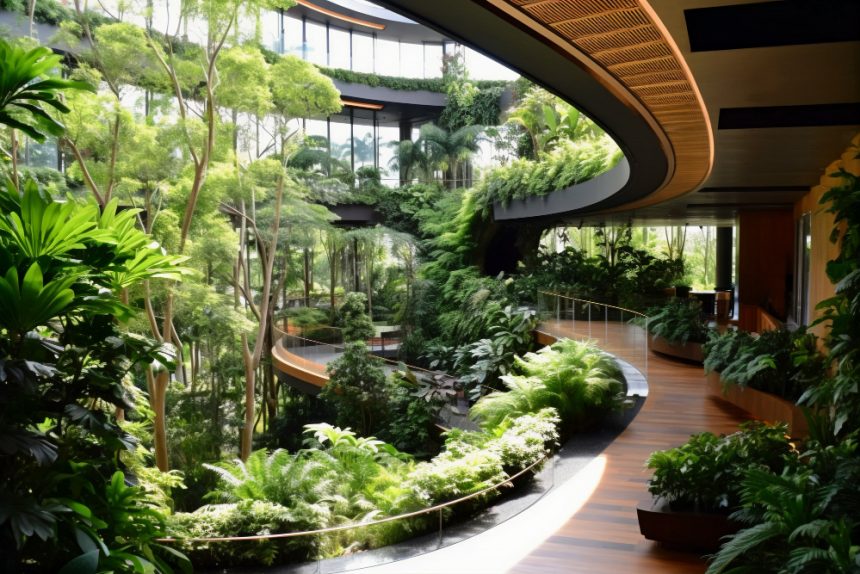In today’s fast-paced urban world, space is at a premium. Skyscrapers soar high, but often walls and vertical surfaces remain blank and unused. That’s where vertical gardens come in—an innovative, eco-friendly way to bring greenery into tiny or awkward spots. These living walls, also known as green walls or living walls, are revolutionizing how we think about gardening and urban landscaping. They turn plain, often neglected surfaces into lush, vibrant displays of nature. Whether you have a small apartment, a city office building, or a public park, vertical gardens can be both practical and visually stunning. Let’s explore what these gardens are, why they’re so popular, and how you can create your own green wall to brighten up any space.
What Are Vertical Gardens and Why Are They Gaining So Much Popularity Today?
Imagine walking past a bare brick wall that transforms into a mini jungle, or a dull boundary wall sprinkled with colorful flowers and green leaves. That’s essentially what vertical gardens do—they convert vertical surfaces into bursting green spaces. Also called living walls or green walls, these systems integrate plants into vertical arrangements, making use of previously unused space.
You might be curious about what makes these gardens so special. Well, one major reason is their ability to maximize limited space, especially in dense urban settings. Instead of sprawling across ground areas—which are often small or already used—vertical gardens make use of existing walls, fences, or building facades. They’re perfect for apartments, offices, or public buildings where ground space is scarce but greenery is desired.
Beyond their eye-catching looks, vertical gardens offer real environmental benefits. They can improve air quality by filtering pollutants, reduce noise pollution in busy areas, and help lower indoor or outdoor temperatures by acting as natural insulators. This makes buildings more energy-efficient and adds to urban sustainability. Plus, they’re versatile—plants can be chosen to suit different climates, from hardy succulents in hot, sunny spots to lush ferns and flowering plants in shadier areas.
So, how do these gardens work? Most vertical garden setups involve installing a supporting structure—like a frame, panel, or pocket system—onto a wall. This structure is then filled with planting media—soil, felt, or other growing mediums—and designed to hold plants comfortably. You can include a wide range of plants, from low-maintenance succulents that need infrequent watering to vibrant flowering plants for visual appeal or even edible herbs for practical use. Modern systems often incorporate drip irrigation, self-watering designs, or simple watering techniques to keep everything hydrated without much fuss.
Why are vertical gardens catching on so quickly? Mainly because they’re perfect for the modern, eco-conscious lifestyle. They add a contemporary, artistic touch to any environment—think of it as bringing nature into urban design in a big way. Homeowners love them as stylish interior features, businesses see them as a way to enhance corporate images, and city planners value their contribution to greener cities. As more of us look for sustainable, space-saving ways to enjoy plants, these living walls offer a practical and attractive solution.
How to Create Your Own Vertical Garden: Tips, Tricks, and Things to Keep in Mind for a Green Space That Thrives
Thinking about jumping into vertical gardening? It’s a rewarding project that can truly transform a dull wall into a lush haven. But before you start planting, it’s good to know a few basics to ensure your garden thrives and stays beautiful over time. Whether you want a small vertical display in a cozy apartment nook or a sprawling outdoor green wall, these tips will help you get started smoothly.
1. Choose the Right Location:
Indoor or outdoor, location matters. Indoors, your plants will need to tolerate lower light conditions—think pothos, ferns, or certain orchids. Outdoors, you can take advantage of more sunlight, so plants like succulents, climbers, or flowering plants may be better suited. Also, consider exposure to wind, rain, and sun to pick the most suitable wall.
2. Decide on the Structure:
Do you want a ready-made kit or a custom build? There are many DIY options and modular systems available that come with planting panels, waterproof backing, and easy-to-install frames. For outdoor setups, ensure the structure is weather-resistant. For indoor projects, choose lightweight materials that won’t damage your wall.
3. Consider Watering and Drainage:
Watering is often the trickiest part of vertical gardening. A good drip irrigation system or self-watering plan can keep things simple and reduce the chance of overwatering. Proper drainage is essential—standing water can cause root rot and other issues. Selecting plants with similar watering needs will make maintenance easier and more straightforward.
4. Pick the Right Plants:
Mixing plants that require similar environmental conditions makes your garden easier to care for. For instance, combine drought-tolerant succulents with shade-loving ferns if their watering and sunlight needs align. Think about aesthetics too—colorful flowers or textured foliage can add visual interest.
5. Nutrients and Maintenance:
Plants in vertical gardens often need extra nutrients because fertilizers wash away faster than in traditional gardens. Regular fertilizing, pruning, and pest checks will keep your wall looking healthy. Also, remove any dead or struggling plants promptly to prevent issues from spreading.
6. Regular Care and Monitoring:
Keep a routine of checking your plants for pests, diseases, and overall health. Prune when necessary, clean irrigation filters, and replace any plants that don’t thrive. With a little consistent attention, your vertical garden will be a lively, manageable work of art.
Creating a vertical garden can be a fun and fulfilling way to add green life to limited spaces. It’s about more than just planting—it’s designing a healthy, life-sustaining system that brightens your environment and boosts your mood. Whether you’re a complete beginner or a seasoned gardener, with patience and some good tips, your vertical garden can become a stunning, thriving feature that brings a touch of nature into your daily life.
Vertical gardens represent a fresh, innovative approach to urban greening—making the most of vertical spaces to enhance both aesthetics and environmental health. With a little planning and creativity, anyone can turn a bland wall into a vibrant, green haven. So, why not give it a try and bring a little more nature into your limited space? It’s easier, more stylish, and more sustainable than ever before.







